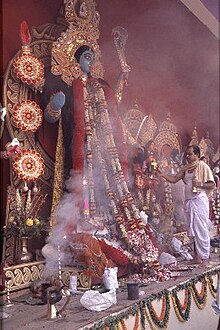Puja (Hinduism)

Pūjā or alternative transliteration Pooja, (Devanagari: पूजा) (Sanskrit: reverence, honour, adoration, or worship) is a religious ritual performed by Hindus as an offering to various deities, distinguished persons, or special guests. It is done on a variety of occasions and settings, from daily puja done in the home, to temple ceremonies and large festivals, or to begin a new venture.[1] Puja is modeled on the idea of giving a gift or offering to a deity or important person and receiving their blessing (Ashirvad). The two main areas where puja is performed is in the home and at public temples. There are many variations in scale, offering, and ceremony.[2] Puja is also performed on special occasions such as Durga Puja and Lakshmi Puja. The puja ritual is performed by Hindus worldwide. Various poojas are performed at various times of the day and on various occasions.
Temple puja
Temple poojas are more elaborate and typically done several times a day. They are also performed by a temple priest, or pujari. In addition, the temple deity (patron god or goddess) is considered a resident rather than a guest, so the puja is modified to reflect that; for example the deity is "awakened" rather than "invoked" in the morning. Temple pujas vary widely from region to region and for different sects, with devotional hymns sung at Vaishnava temples for example. At a temple puja, there is often less active participation, with the priest acting on behalf of others.[1]
Offerings


A full home or temple puja can include several traditional upacaras or "attendances". The following is an example puja that can vary according to tradition, setting, or time:[1] food, drink or everyday objects may be offered. Indologist Jan Gonda has identified 16 steps (shodasha upachara) that are common in all varieties of puja:[3]
- Avahana (“invocation”). The deity is invited to the ceremony from the heart.
- Asana. The deity is offered a seat.
- Padya. The deity’s feet are symbolically washed.
- Water is offered for washing the head and body
- Arghya. Water is offered so the deity may wash its mouth.
- Snana or abhisekha. Water is offered for symbolic bathing.
- Vastra (“clothing”). Here a cloth may be wrapped around the image and ornaments affixed to it.
- Upaveeda or Mangalsutra. Putting on the sacred thread.
- Anulepana or gandha. Perfumes and ointments are applied to the image. Sandalwood paste or kumkum is applied.
- Pushpa. Flowers are offered before the image, or garlands draped around its neck.
- Dhupa. Incense is burned before the image.
- Dipa or Aarti. A burning lamp is waved in front of the image.
- Naivedya. Foods such as cooked rice, fruit, clarified butter, sugar, and betel leaf are offered.
- Namaskara or pranama. The worshipper and family bow or prostrate themselves before the image to offer homage.
- Parikrama or Pradakshina. Circumbulation around the deity.
- Taking leave.
Sometimes additional steps are included:
- Dhyana (“Meditation”). The deity is invoked in the heart of the devotee.
- Acamanıya. Water is offered for sipping.
- Aabaran. The deity is decorated with ornaments.
- Chatram. Offering of umbrella.
- Chamaram Offering of fan or fly-whisk (Chamara).
- Visarjana or Udvasana. The deity is moved from the place.
There are variations in this puja method such as:
- Pancha upachara pooja (puja with 5 steps).
- Chatushasti upachara puja (puja with 64 steps).
Guru puja
In the case of the greatest spiritual masters as Shivananda let’s say, there is the custom to realize puja with a living object of adoration, meaning we choose them as objects of puja, honor them as living gods or we see and adore specific gods in their body, putting on them symbolic clothes and ornaments, garlands around their neck, incense around them, washing their feet, anointing their feet, giving them fruits, food and drinks and meditating at their feet, asking for their blessing.
In the Hindu tradition the Guru it is looked upon as the embodiment of God himself.
Short list of puja festivals
- Diwali/Deepavali/Lakshmi Puja
- Durga Puja
- Ganesh Chaturthi
- Holi
- Kali Puja
- Maha Shivaratri
- Rath Yatra/Jagannath Puja
- Raksha Bandhan
- Saraswati Puja
See also
- Coconut: use for worship
- Darśana
- Jainism: geographical spread and influence, historical roots of puja
- Panchalinga Darshana
- Prasad
- Puja (Buddhism)
- Satyanarayan Puja
References
- ^ a b c Lindsay Jones, ed. (2005). Gale Encyclopedia of Religion. Vol. 11. Thompson Gale. pp. 7493–7495. ISBN 0-02-865980-5.
- ^ Flood, Gavin D. (2002). The Blackwell companion to Hinduism. Wiley-Blackwell. pp. 6–7. ISBN 978-0-631-21535-6.
- ^ Fuller, C. J. (2004), The Camphor Flame: Popular Hinduism and Society in India (PDF), Princeton, NJ: Princeton University Press, p. 67, ISBN 978-0-691-12048-5
External links
- Murti Puja on Hindupedia, the Hindu Encyclopedia
- Why do Hindus have a puja room ?
